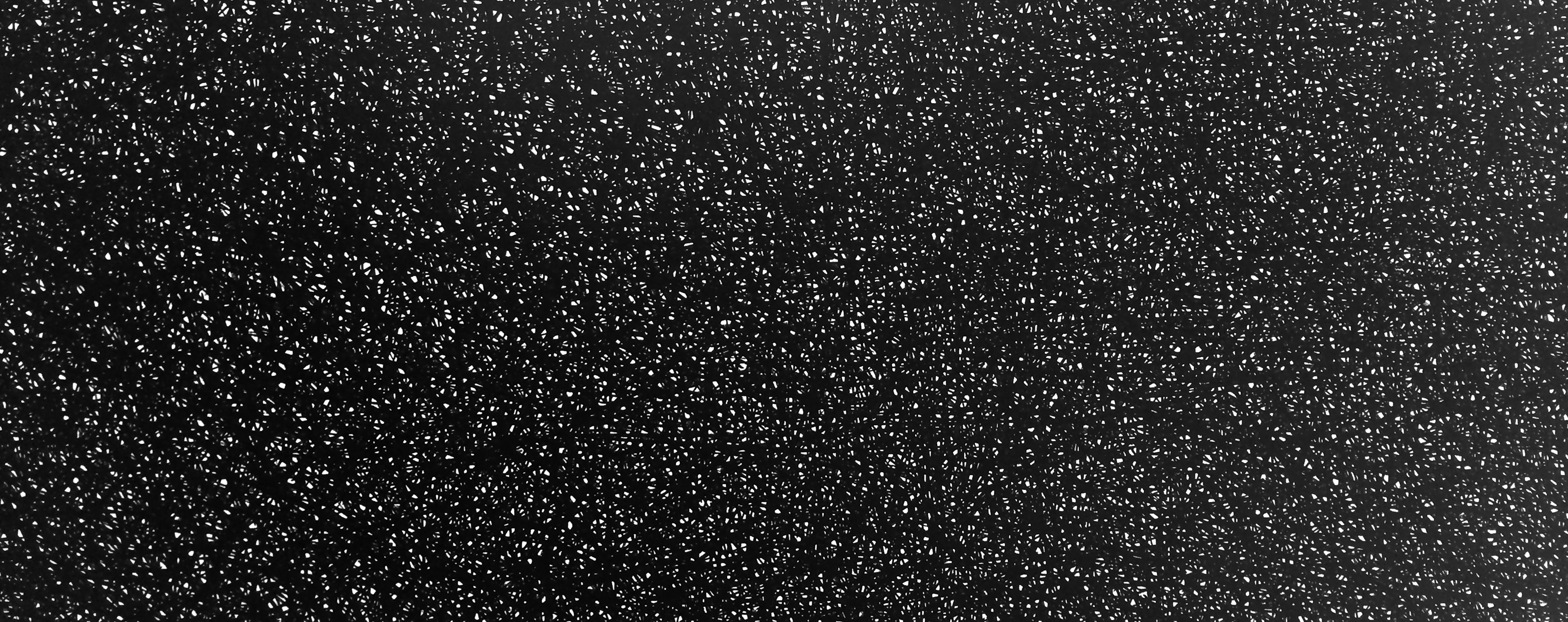Sol LeWitt
- Sol LeWitt
Within a four-meter (160”) circle, draw 10,000 black straight lines and 10,000 black not straight lines. All lines are randomly spaced and equally distributed.
August 2005
Marker
Yale University Art Gallery
Gift of the LeWitt Collection, Chester, Connecticut, in honor of Terry and Richard Albright, B.A. 1961
First Installation
Galerie Sfeir-Semler, Beirut, Lebanon
First Drawn By
Antoine Joseph Helou, Christine Streuli, Rayyan Tabet
MASS MoCA Building 7
Third Floor
On first glance, Wall Drawing 1180 appears to be a consuming, absorbing black mass. But looking closer, one notices the little pockets and triangles of white where the marker didn’t quite fill everything in the circle, even with 20,000 total lines which make up the drawing. It’s more web than solid geometry; backing up and looking right into the center of the drawing, one is lost in the medium, both due to the compact character of the work and its execution near the windows on the third floor.
Wall Drawing 1180 is consistent with LeWitt’s long-held ideas wherein, as Andrea Miller-Keller writes, the “medium and support are almost merged.” That is, the marker is drawn directly on the unprimed wall and the “orange-peel” texture of the wall shows through – as seen in LeWitt’s early graphite works (Ground Floor) and mid-career ink-wash drawings (Second Floor).
At the same time, however, Wall Drawing 1180 (first executed in 2005) no doubt looks toward the scribble drawings LeWitt begins in 2003, with Wall Drawing 1094 (see Backstory). Combining both “black straight lines” (as seen in Wall Drawing 86) and “black not straight lines” (as seen in Wall Drawing 46) results in an all-over, layered pattern seen in the scribble drawings around the corner to the right. John Hogan, senior LeWitt drafter in the 1980s and current Mary Jo and Ted Shen Installation Director and Archivist of Sol LeWitt Wall Drawings at the Yale University Art Gallery, speaks to the execution of Wall Drawing 1180:
“It’s simply trusting your eye and hand. You go in and make your first pass at the wall, and maybe you make the lines all a foot apart. You figure out what maybe 1000 lines look like on the wall, and you get the spacing tighter and tighter until you’ve done them all.”
Wall Drawing 1180 is confined to a simple shape, a circle, yet still explores the “vagaries of the human hand” LeWitt was so interested in (Hogan 2016). “Sometimes people approach me and say LeWitt ‘lets you do whatever you want,’” Hogan said. “Yeah, he says you can use A and B and do whatever you want. He’s giving you the freedom of expression but within a frame of instructions.”
Backstory
Wall Drawing 1180 was executed in 2010 after Wall Drawing 1094 had been damaged in the months after the opening of the retrospective. Wall Drawing 1180 was chosen for its considerable durability; however, according to Hogan, it was also chosen because it had been executed incorrectly in its first installation in Beirut.
“It’s one of the situations where none of the [LeWitt] Studio draftspeople were able to go [execute the drawing], and the gallery did not follow the instructions exactly.”
The bottom and top of the circle in Wall Drawing 1180 as drawn in Lebanon were cut off (and the lines not equally distributed), and Hogan decided that executing 1180 at MASS MoCA would also allow the Estate to accurately update its records on Wall Drawing 1180.
Wall Drawing 1180 is executed using water-based pigmented markers; regular markers have too high an acidic content and would cause the wall to deteriorate over time. LeWitt did not specify the width of the marker tip, but the drawing is executed with commonly manufactured chisel-tip markers — an everyday, vernacular, international medium.


